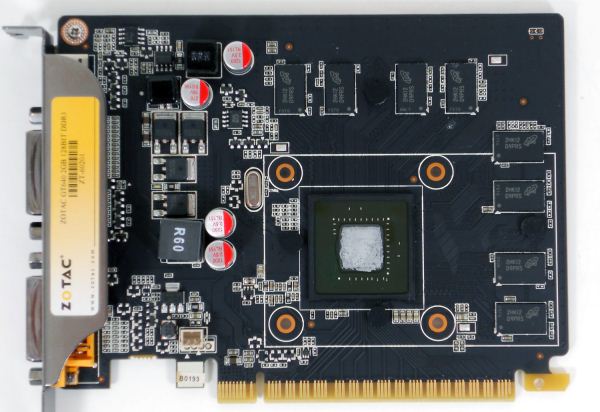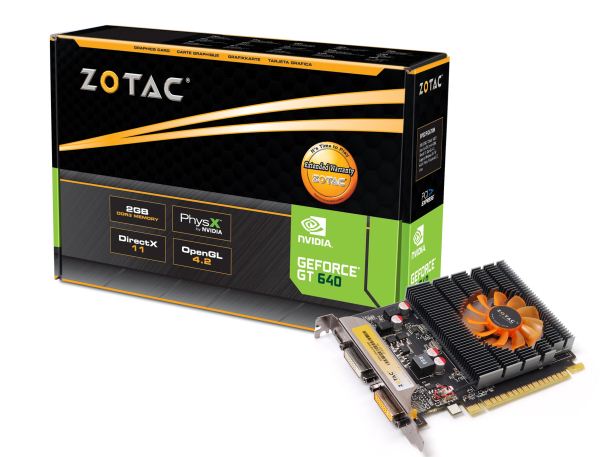Zotac GeForce GT 640 DDR3 Review: Glacial Gaming & Heavenly HTPC
by Ryan Smith & Ganesh T S on June 20, 2012 12:00 PM ESTMeet The Zotac GeForce GT 640 DDR3
As we mentioned in our introduction NVIDIA is not sampling a reference GT 640, leaving that up to their partners. As always NVIDIA’s partners have spread out with a variety of designs ranging from low-profile cards to relatively large double-slot cards, with a few even trying their hand at factory overclocking. Today we’ll be taking a look at Zotac’s GeForce GT 640, a design that’s right in the middle of those extremes and fairly close to NVIDIA’s internal reference design.
Taking things from the top, at this moment Zotac is in a rather unique position with their design. They currently offer the only single-slot GT 640 available at retail, with every other card being a double-slot card to fit a larger cooler. Consequently for users with ITX cases where space is at a premium, Zotac’s GT 640 is generally going to be the only option.
Because the Zotac GT 640 is a single-slot card, Zotac’s cooler of choice is a fairly wide but shallow aluminum heatsink that spans roughly half of the card. At the center of the heatsink is a fairly small 2pin 55mm fan, which provides the necessary airflow to keep the card cool. The card’s DDR3 RAM is sitting underneath the heatsink, but no contact is made nor is it necessary due to DDR3’s very low operating power and temperatures.
Removing the heatsink we see the bare PCB, with the GK107 GPU and DDR3 mounted on it. Physically GK107 is an unremarkable GPU and the entire package appears to be roughly the same size as GF108’s GPU package. On this Zotac card it’s paired with 8 2Gb Micron DDR3-1866 modules operating in 16bit mode, which means for casual overclocking there should be a bit of headroom, but GPU DDR3 is rarely capable of going much past its rated speeds.
The rest of the PCB is solid yet simple; users worried about coil whine will be glad to see that Zotac is using solid chokes here as opposed to ring chokes, and we didn’t notice any coil whine during operation. The card measures 5.75” long – the minimum length necessary for a PCIe x16 card – so it should fit in virtually any full-profile case.
Meanwhile looking at the ports on the card’s bracket, we find NVIDIA’s favored configuration of 1 DL-DVI-I port, 1 DL-DVI-D port, and a mini-HDMI port. As one of the major improvements in the Kepler family NVIDIA now has more than 2 display controllers on their GPUs, so the GT 640 can actually drive all 3 ports simultaneously. You likely wouldn’t want to use the GT 640 for gaming but it’s certainly powerful enough for desktop work, and this is one of the few situations where that extra 1GB of VRAM might come in handy.


Top: Zotac GeForce GT 640. Bottom: NVIDIA Reference GeForce GT 640
Unfortunately the display ports on Zotac’s GT 640 also expose its one flaw, and it’s a big one. On NVIDIA’s reference design the mini-HDMI port is centered at the middle of the card, similar to the DVI ports. However for reasons unknown to us, Zotac has moved the mini-HDMI port on their GT 640 down by about 2mm. This doesn’t sound like much, but by putting the mini-HDMI port so close to the edge of the card it introduces a crippling flaw: it doesn’t leave any room for a cable to attach to it.

Zotac GeForce GT 640 Installed. Note the lack of clearance around the mini-HDMI port
Specifically, because the port is so low it’s right on the edge of the usable area of the bracket, as everything below the port will be covered by the I/O shielding of the computer case. Consequently if you attempt to plug in a mini-HDMI cable or adapter, the boot of the cable will run into the case’s I/O shielding before the cable is fully inserted, preventing the cable from getting a good connection and/or locking into place. The HDMI specification is actually rather strict about the size of the boot on mini-HDMI cables/adapters, and after having tested a few different adapters everything we’ve encountered is within spec, so this is poor planning on Zotac’s part. NVIDIA’s reference design and cards similar to it do not have this problem since if the port is properly centered it leaves plenty of space for the boot, which is why this is the first time we’ve run into this issue.
We’ve already brought this up with Zotac and they’ve told us that they intend to fix it once they’ve exhausted their current supply of brackets and mini-HDMI connectors, but for the time being all of their GT 640 cards will have this flaw. In the meantime the problem is not unworkable – with enough tampering it should be possible to force a mini-HDMI cable/adapter in there – but Zotac really shot themselves in the foot here by making the mini-HDMI port so inaccessible. On that note, if you do intend to take advantage of this port you’ll need to bring your own gear (Zotac doesn’t provide a mini-HDMI adapter), and you’ll want to either use a cable or a more specialized mini-HDMI-to-HDMI adapter. The stubby adapter Monoprice and most other retailers carry won’t work because the port is so close to the top of the bracket, which has been a recurring quirk with NVIDIA cards since NVIDIA started using the mini-HDMI port.
Moving on, rounding out the package is the typically bare minimum collection of extras found on budget cards. Along with a driver CD and quick start guide Zotac includes a DVI-to-VGA adapter, but not a mini-HDMI adapter. Zotac typically bundles Ubisoft games with their cards but on a budget card like this that isn’t really possible, so the GT 640 comes with the next best thing, which is a 3 day trial of TrackMania 2.
Finally, as we stated earlier the Zotac GT 640 is currently priced at $109 at Newegg and most other retailers, which makes it on-par with most other GT 640 cards. Meanwhile for the warranty Zotac is offering a base 2 year warranty, which is extended to a rather generous full limited lifetime warranty upon registration of the card.













60 Comments
View All Comments
HighTech4US - Wednesday, June 20, 2012 - link
At least hen the GT240 was released it came in both DDR3 and GDDR5.UNhooked - Wednesday, June 20, 2012 - link
I wish there was some sort of Video encoding benchmark. I have been told AMD/ATI cards aren't very good when it comes to video encoding.mosu - Thursday, June 21, 2012 - link
who told you that kind of crap ?Please check the internet.Rumpelstiltstein - Thursday, June 21, 2012 - link
Did this low-end offering really manage to pull off these kind of numbers? I'm impressed. Not something I would buy personally, but I would have no problems recommending this to someone else.Samus - Thursday, June 21, 2012 - link
DDR3....ruined a perfectly good chip.Deanjo - Thursday, June 21, 2012 - link
Noooooo! Come on, post some benchmarks as it is right now. Some of us do not want to wait for AMD to get their VCE in order. People have been waiting for VCE for months and there is no valid reason to hold off NVENC waiting for their competitor to catch up. When and if VCE support comes out then run a comparison then.
ganeshts - Thursday, June 21, 2012 - link
NVIDIA indicated that official NVENC support in CyberLink / ArcSoft transcoding applications would come in July only. Till then, it is beta, and has scope for bugs.Deanjo - Thursday, June 21, 2012 - link
So? That didn't prevent them benching trinity and it's encoding capabilities despite it all being beta there.http://www.anandtech.com/show/5835/testing-opencl-...
drizzo4shizzo - Thursday, June 21, 2012 - link
So... do these new cards still support HDTV 1080i analog signals for those of us who refuse to give up our 150lb 34" HDTV CRTs?ie. ship with a breakout dongle cable that plugs into the DVI-I port? If they don't ship with one can anyone tell me if they are compatible with a 3rd party solution? For it to work the card has to convert to the YUV colorspace. My old 7600gt *did* support this feature, but none of the new cards mention it...
Upgrading my TV also means buying a new receiver for HDMI switching to the projector, fishing cable in walls, and all manner of other unacceptable tradeoffs. Plus monay.
Thanks!
philipma1957 - Thursday, June 21, 2012 - link
I have a sapphire hd7750 ultimate passive cooled card.This card seems to be worse in every case except it is 1 slot not 2.
The passive hd7750 is 125 usd this is 110 usd.
I am not sure that I would want this until they make a passive version.